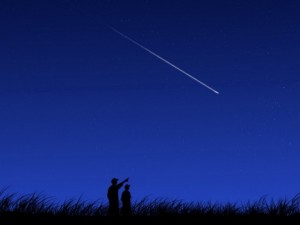Ten tips for watching the Geminid meteor shower

Via Cumbrian Sky
|
|
In 2012, the new moon falls on December 13, guaranteeing dark nights for this year’s Geminid meteor shower. It doesn’t get much better than this for watching a major meteor shower! As a general rule, it’s either the August Perseids or the December Geminids that gives us the best meteor shower of the year.
Even from a mildly light-polluted town, you may see some meteors! Best direction to look? Like all meteors in annual showers, the meteors will appear in all parts of the sky. Find an open sky and – if possible – a sky sheltered from artificial lighting.
You’ll find EarthSky’s top 10 tips for watching this shower below.

Geminid meteors. Image Credit: Navicore
2. Dark skies away from the glare of city lights are important, even on a moonlit night For optimum viewing, find a place to observe in the country.
3. The 2012 Geminid meteor shower will be better if you let your eyes adapt to the dark. Sometimes that takes as long as twenty minutes. So give yourself at least an hour of viewing time. The most Geminids usually fall in the wee hours after midnight, centered around 2 a.m. local time. That time hold true no matter your time zone.
4. If you were to track the Geminid meteors backwards on the sky’s dome, you’d find them streaming from a point in the sky within the boundaries of the constellation Gemini the Twins. Hence this shower’s name. The Geminid radiant point climbs over the eastern horizon around 7 p.m. local time for our mid-northern latitudes. The early rising time for the radiant point is why the Geminid shower is one of the few meteor showers worth watching in the evening hours. That’s good for people who aren’t night owls!
5. The Geminid radiant point lies close to a noticeable bright star – one of the Gemini “twins” – the star Castor. You don’t need to know Castor or the constellation Gemini to enjoy the Geminid meteor shower. All you need is an open view of the sky. But the Geminids will streak through many different constellations. So try learning a constellation or two. Many people find a star wheel very helpful.
6. In 2012, check out the planets. A diligent observer might catch all five visible planets in the December 2012 sky. Mars and Jupiter shine in the evening sky, and Jupiter is way too bright to miss. Watch Saturn rise around 4 a.m. Just before dawn, Venus – the sky’s brightest planet – rises into your eastern sky and the innermost planet Mercury follows Venus into the sky about one-half hour thereafter, or as the predawn darkness is giving way to dawn. Need help? Try EarthSky’s December 2012 guide to the visible planets.
7. Most meteors in annual showers originate in comets. But the parent of the Geminid meteor shower is a mysterious body named 3200 Phaethon. This solar system object is termed an Apollo (near-Earth) asteroid, and it might be a dormant comet. How does that help you watch the shower? It doesn’t. But it’s fun to think about.
8. The best way to watch meteors is to bring along a buddy. Both of you watch different parts of the sky. If one of you sees one, shout out “meteor!” If you don’t know which way to look, don’t worry. Just let your eyes rove casually in all parts of the sky.
9. Special equipment? Not necessary. You only need a dark sky, a reclining lawn chair and the warmth of a sleeping bag. A hot drink is also good. Just remember. Watching a meteor shower is not like turning on the television. You can’t expect to just look out the window, or simply step outside to see meteors. Your eyes take some 20 minutes to dark-adapt. If you’re serious about it, give yourself at least an hour of viewing time. Even the best meteor showers have lulls and spurts.
10. As a wise man once said, meteor watching is a lot like fishing. You go outside. You enjoy nature all around you. You hope you catch some!
More about meteors …
How high up are meteors?
Whoosh!Can you hear a meteor streak past?



0 Comments:
Post a Comment
<< Home